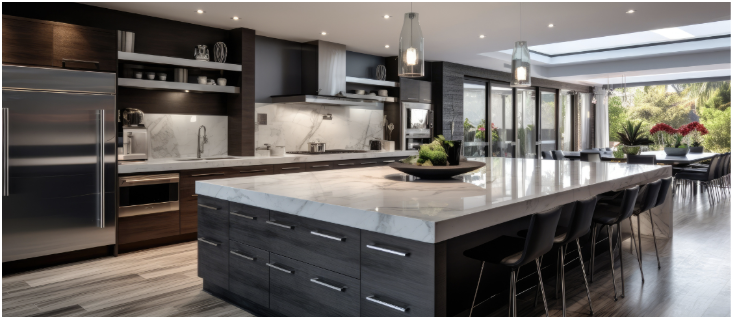Dreaming of a stunning new kitchen or a spa-like bathroom retreat? You're not alone! These are two of the most popular home renovation projects. But before you dive headfirst into demolition, there's one crucial question you need to answer: How much will it really cost? This comprehensive guide breaks down the factors influencing kitchen and bathroom remodel costs, helping you create a realistic budget and avoid those dreaded overspending surprises.
The Wild World of Remodel Costs: It's Not One-Size-Fits-All
Let's be clear: there's no magic number for kitchen or bathroom remodel costs. The price tag can vary wildly based on a multitude of factors. Think of it like buying a car – a basic sedan will cost significantly less than a luxury SUV. Similarly, a simple refresh will differ drastically from a complete gut renovation.
Key Factors Influencing Remodel Costs:
Location, Location, Location: Construction costs vary significantly across the country. Labor, materials, and even permitting fees can be higher in some areas than others. A remodel in a major metropolitan area will generally cost more than the same project in a smaller town.
Scope of the Project: This is the biggest cost driver. Are you simply painting cabinets and replacing hardware, or are you moving walls, changing plumbing, and installing custom cabinetry? A minor refresh will obviously be less expensive than a full gut renovation.
Size of the Space: A small powder room remodel will cost less than a large master bathroom overhaul. Similarly, a galley kitchen renovation will be cheaper than a large, open-concept kitchen remodel.
Materials and Finishes: The choices you make for cabinets, countertops, flooring, tile, fixtures, and appliances will significantly impact your budget. High-end materials like marble countertops and custom cabinetry will drive up costs compared to more budget-friendly options like laminate countertops and stock cabinets.
Labor Costs: Hiring skilled contractors, plumbers, electricians, and other professionals is essential for a successful remodel. Labor costs vary depending on the location and the complexity of the project.
Permits and Inspections: Don't forget about permits! These are required for most major renovations and can add to the overall cost. Inspections are also necessary to ensure the work is up to code.
Unexpected Issues: Older homes can often reveal hidden problems during demolition, such as mold, rot, or outdated plumbing. It's crucial to have a contingency fund (typically 10-20% of your budget) to cover these unforeseen expenses.
DIY vs. Professional: While DIYing some aspects of the remodel can save money, it's essential to be realistic about your skills and time commitment. Complex tasks like plumbing and electrical work should always be left to professionals.
Breaking Down the Costs: Kitchen Remodels
Kitchen remodels tend to be one of the most expensive home improvements. Here's a general breakdown of where your money might go:
Cabinets (25-35%): Cabinets are a major investment. Options range from stock cabinets (most affordable) to semi-custom and custom cabinets (most expensive). Refacing existing cabinets is a cost-effective option if they are in good condition.
Countertops (10-15%): Countertop materials vary widely in price. Granite, quartz, and marble are popular choices, while laminate and butcher block are more budget-friendly.
Appliances (15-20%): Appliance costs can range from a few thousand dollars to tens of thousands, depending on the brand, features, and size.
Flooring (5-10%): Tile, hardwood, and laminate are common kitchen flooring choices. Tile can be more expensive to install but offers durability and water resistance.
Backsplash (5-10%): The backsplash is a great way to add style to your kitchen. Tile, stone, and even glass are popular options.
Plumbing (5-10%): Plumbing costs will depend on whether you are simply replacing fixtures or moving plumbing lines.
Electrical (5-10%): Upgrading electrical wiring and adding new outlets may be necessary, especially in older homes.
Lighting (5-10%): Good lighting is essential in a kitchen. Consider a combination of ambient, task, and accent lighting.
Labor (20-30%): Labor costs will vary depending on the complexity of the project and your location.
Breaking Down the Costs: Bathroom Remodels
Bathroom remodels, while often smaller in scale than kitchens, can still be a significant investment. Here's a cost breakdown:
Tile (20-30%): Tile is a major expense in bathroom remodels, used for flooring, shower surrounds, and backsplashes. Ceramic and porcelain tile are more affordable than natural stone.
Vanity (15-20%): Vanities come in a wide range of styles and prices. Consider the size, material, and storage options.
Toilet (5-10%): Toilets are a relatively inexpensive part of the remodel, but installation costs can vary.
Shower/Tub (15-25%): Replacing a shower or tub can be a significant expense, especially if you are changing the layout or installing a custom shower enclosure.
Fixtures (10-15%): Faucets, showerheads, and other fixtures can add up quickly. Choose quality fixtures that will last.
Plumbing (10-15%): Plumbing costs can vary depending on whether you are simply replacing fixtures or moving plumbing lines.
Electrical (5-10%): Updating electrical wiring and adding new outlets may be necessary, especially for lighting and ventilation.
Ventilation (5-10%): Proper ventilation is crucial in a bathroom to prevent mold and mildew.
Labor (20-30%): Labor costs will vary depending on the complexity of the project and your location.
Creating a Realistic Budget: The Nitty-Gritty
Now that you understand the cost factors, how do you create a realistic budget?
Define Your Scope: Clearly outline what you want to achieve with your remodel. Are you looking for a cosmetic refresh or a complete overhaul?
Research Local Costs: Get estimates from several contractors in your area. This will give you a good sense of local labor and material costs.
Prioritize Your Needs: Decide which aspects of the remodel are most important to you. This will help you allocate your budget effectively.
Create a Detailed Spreadsheet: List all the elements of your remodel and estimate the cost for each. Include materials, labor, permits, and a contingency fund.
Get Multiple Quotes: Don't settle for the first contractor you meet. Get at least three quotes to compare prices and services.
Factor in Unexpected Costs: Add a contingency fund (10-20% of your budget) to cover any unforeseen expenses.
Track Your Spending: Keep track of all your expenses throughout the remodel to stay on budget.
Tips for Saving Money:
Consider a phased approach: If your budget is tight, you can break the remodel into phases, starting with the most important updates.
Shop around for materials: Compare prices from different suppliers and look for sales and discounts.
Consider DIY for some tasks: If you are handy, you can save money by doing some of the work yourself, such as painting or demolition.
Choose budget-friendly materials: There are many affordable options available for cabinets, countertops, and flooring.
Keep the layout the same: Moving plumbing lines and walls can significantly increase costs.
Be flexible: Be prepared to make adjustments to your plans if you encounter unexpected issues or cost overruns.
The Bottom Line:
Remodeling your kitchen or bathroom is a significant investment, but with careful planning and budgeting, you can create the space of your dreams without breaking the bank. By understanding the factors that influence costs and creating a realistic budget, you can avoid those dreaded overspending surprises and enjoy a smooth and successful renovation process. Remember, a well-planned project is a project that's more likely to come in on time and on budget, leaving you with a beautiful and functional space you'll love for years to come.
Subscribe to Cabinet Wholesalers's Blog









Comments